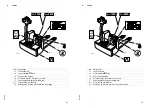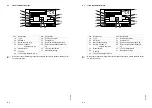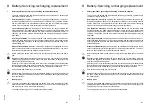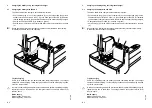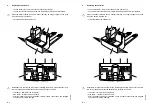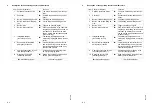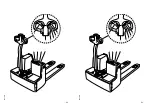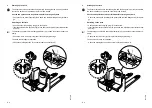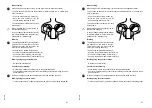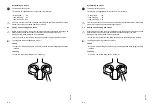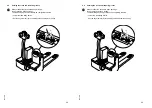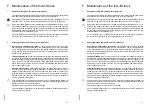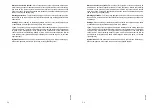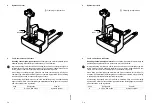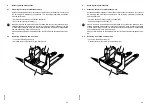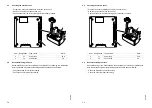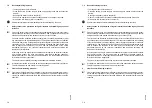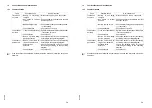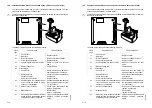
E 5
0301
.GB
4
Operation of the fork lift truck
4.1
Safety regulations applicable when operating the truck
Driving lanes and work areas:
Only such lanes and routes that are specially alloca-
ted for truck traffic must be used. Unauthorized persons must stay away from work
areas. Loads must only be stored at places specially provided for this purpose.
Driving conduct:
The travelling speed must be adapted to the prevailing local con-
ditions. The truck must be driven at slow speed when negotiating bends or narrow
passages, when passing through swing doors and at blind spots. The driver must al-
ways observe an adequate braking distance between the fork lift truck and the vehicle
in front and he must be in control of his truck at all times. Sudden stopping (except in
emergencies), rapid U-turns and overtaking at dangerous or blind spots is not permit-
ted. It is forbidden to lean out of or reach beyond the working and operating area.
Visibility:
The driver must look in the direction of travel and must always have a clear
view of the route ahead. When loads blocking the view are carried, the fork lift truck
must be driven with the load at the rear. If this is not possible, a second person must
walk in front of the fork lift truck to give suitable warnings.
Negotiating slopes and inclines:
Negotiating of slopes and inclines is permitted
only when they are recognised lanes, when they are clean and non-slipping, and
when the technical specification of the truck permits safe driving on such slopes or
inclines. Loads must always be carried at that end of the truck facing uphill. U-turns,
cutting obliquely over slopes or inclines and parking of the fork lift truck on slopes or
inclines is not permitted. Inclines must only be negotiated at slow speed, with the
driver ready to brake at any moment.
Use of lifts and driving on loading platforms:
Lifts and loading platforms must only
be used if they are of adequate load bearing capacity, if suitable for driving on, and if
authorised by the user of the truck for truck traffic. The fork lift truck driver has to sa-
tisfy himself accordingly before driving into lifts or on to loading platforms. The truck
must enter lifts with the load in front and must take up a position which does not allow
it to come into contact with the walls of the lift shaft. Persons riding in the lift together
with the fork lift truck must only enter the lift after the fork lift truck has come safely to
a standstill, and must leave the lift before the fork lift truck.
Nature of the loads carried:
Only loads that have been safely and correctly secured
must be carried. Never transport loads stacked higher than the top of the fork carria-
ge, or stacked higher than the guard grille.
Towing trailers:
The maximum trailer load given for the fork lift truck for braked and/
or unbraked trailers must not be exceeded. The trailer load must be properly secured
and must not exceed the dimensions permitted for the driving routes. After attaching
the trailer but before starting driving, the driver must check that the trailer attachment
is secured against detachment. Towing fork lift trucks must be operated in such a
manner that safe driving and braking of the truck and the trailer is guaranteed for all
driving movements.
E 5
0301
.GB
4
Operation of the fork lift truck
4.1
Safety regulations applicable when operating the truck
Driving lanes and work areas:
Only such lanes and routes that are specially alloca-
ted for truck traffic must be used. Unauthorized persons must stay away from work
areas. Loads must only be stored at places specially provided for this purpose.
Driving conduct:
The travelling speed must be adapted to the prevailing local con-
ditions. The truck must be driven at slow speed when negotiating bends or narrow
passages, when passing through swing doors and at blind spots. The driver must al-
ways observe an adequate braking distance between the fork lift truck and the vehicle
in front and he must be in control of his truck at all times. Sudden stopping (except in
emergencies), rapid U-turns and overtaking at dangerous or blind spots is not permit-
ted. It is forbidden to lean out of or reach beyond the working and operating area.
Visibility:
The driver must look in the direction of travel and must always have a clear
view of the route ahead. When loads blocking the view are carried, the fork lift truck
must be driven with the load at the rear. If this is not possible, a second person must
walk in front of the fork lift truck to give suitable warnings.
Negotiating slopes and inclines:
Negotiating of slopes and inclines is permitted
only when they are recognised lanes, when they are clean and non-slipping, and
when the technical specification of the truck permits safe driving on such slopes or
inclines. Loads must always be carried at that end of the truck facing uphill. U-turns,
cutting obliquely over slopes or inclines and parking of the fork lift truck on slopes or
inclines is not permitted. Inclines must only be negotiated at slow speed, with the
driver ready to brake at any moment.
Use of lifts and driving on loading platforms:
Lifts and loading platforms must only
be used if they are of adequate load bearing capacity, if suitable for driving on, and if
authorised by the user of the truck for truck traffic. The fork lift truck driver has to sa-
tisfy himself accordingly before driving into lifts or on to loading platforms. The truck
must enter lifts with the load in front and must take up a position which does not allow
it to come into contact with the walls of the lift shaft. Persons riding in the lift together
with the fork lift truck must only enter the lift after the fork lift truck has come safely to
a standstill, and must leave the lift before the fork lift truck.
Nature of the loads carried:
Only loads that have been safely and correctly secured
must be carried. Never transport loads stacked higher than the top of the fork carria-
ge, or stacked higher than the guard grille.
Towing trailers:
The maximum trailer load given for the fork lift truck for braked and/
or unbraked trailers must not be exceeded. The trailer load must be properly secured
and must not exceed the dimensions permitted for the driving routes. After attaching
the trailer but before starting driving, the driver must check that the trailer attachment
is secured against detachment. Towing fork lift trucks must be operated in such a
manner that safe driving and braking of the truck and the trailer is guaranteed for all
driving movements.
Summary of Contents for EME 112
Page 1: ...Operating instructions 77800386 EME 112 G 05 00 07 08 ...
Page 3: ...0108 GB 0108 GB ...
Page 7: ...0506 GB 2 0506 GB 2 ...
Page 9: ...0600 GB A 2 0600 GB A 2 ...
Page 25: ...1001 GB D 6 1001 GB D 6 ...
Page 28: ...E 3 0301 GB 5 2 1 4 3 6 7 8 9 10 E 3 0301 GB 5 2 1 4 3 6 7 8 9 10 ...
Page 35: ...0301 GB E 10 0301 GB E 10 ...
Page 47: ......
Page 65: ...0506 GB 18 0506 GB 18 ...

